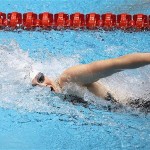The swim is the key to a calm and composed race. Here’s how to exit the water running.
by Terry Laughlin
Newsflash: swimming accounts for 10 percent or less of your total time spent competing in a triathlon. The 90 percent of the race that happens on dry land has far more potential to influence your outcome, in time or placement.
That short time spent in the water, however, makes up for itself with its broad influence. Let’s look at the two main areas where your swim starts to impact the rest of your race.
Stress
The swim experience can be stressful—particularly for a first-timer—and take away much of the pleasure of the overall experience. This happens because either a) you feel unable to exert control of your body, or b) you feel deeply vulnerable—trapped in a sea of densely-packed bodies in deep water. The resulting anxiety and panic will leave you needing to clear adrenaline from your bloodstream once you’re back on land when you’d be better to just send fuel to your muscles—not much fun and not good for your ability to ride.
Maximize your open-water comfort
Meditate on success. Calm pre-race jitters (and block out nervous chatter around you) by doing slow, controlled nose-breathing while visualizing your best form. Nose breathing is a stress-reduction technique. Combining it with visualization primes your brain and muscles to turn visualization into reality. You’re best to practice this before race day—ideally at the end of the lane before practice sessions.
Be the quiet center. If you find yourself in the middle of a splashy pack, turn it into a game. Observe the strokes of those around you and strive to swim with the quietest, most leisurely, stroke of anyone around you. Strategies that insulate you from anxiety and help you feel in control of your swim will also help conserve energy for the bike and run.
Energy
Even if you finish the swim without having felt anxiety, you might have worked so hard that you feel drained for much of the race.
This is because you’ve got a finite number of heartbeats to spend, so to speak, over the course of the cumulative time it takes to complete the event. On land—because of gravity, heat and hills—there will be many times when you’ll have little choice but to expend more energy. The water is the only part of the race where saving this energy to spend later is a viable option. It’s also the most strategic option for any triathlete who did not grow up swimming competitively, because, while it takes only a little more energy to run a little faster, it takes a LOT more energy to swim a little faster.
The key to success in running and cycling is training to get in better shape. The key to optimizing your swim performance, however, is to practice in ways that address the open-water swim.
Minimize your energy output
Swim as a warmup. Imagine that the race actually begins as you mount your bike, that you will simply swim to the start as a warmup. Forming a conscious intention that you will not race during the swim can remove performance pressure. Include swimming at a gentle warmup pace in your visualization. Do entire practices at warmup pace leading up to the race so you’re extra familiar with it—making your visualization all the more realistic.
Choose a focal point. Before the race, choose a specific aspect of your stroke for laser focus. Good choices for nervous newbies include (i) Maintain a ‘weightless’ or neutral head position; (ii) Cut a ‘slot’ with fingers and slide your forearm through on entry; and (iii) Extend your arm without bubbles. Mindfully eliminating bubbles in your stroke also eliminates self-doubt. This also works best if rehearsed in practice.
And, finally, keep a smile on your face throughout the swim as practice for the big smile you’ll display as you high-step out of the water on your way into T1.
Terry Laughlin is the founder of Total Immersion coaching: “Swimming that Changes Your Life.”
Originally from: http://www.ironman.com/triathlon/news/articles/2014/09/swim-impact-on-whole-race.aspx#ixzz3H8hEzFmI

